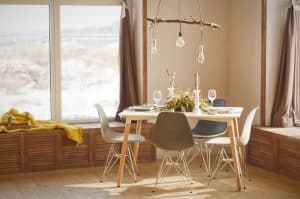Infinite Adaptability Paradigms: Residential Designs Transcending Traditional Boundaries
In today’s ever-evolving world, the term “adaptability” has taken on a whole new meaning, especially in the realm of residential designs. With changing lifestyles, needs, and preferences, it has become increasingly important for homes to transcend traditional boundaries and cater to the needs of the modern homeowner. This has led to the emergence of a new paradigm in the world of design – the infinite adaptability paradigm.
The Rise of Infinite Adaptability Paradigms
In the past, homes were built with a fixed layout, designed to cater to the needs of the occupants at the time of construction. This worked well for years, but as families became smaller, and lifestyles changed, these homes were no longer able to keep up with the changing needs of the homeowners.
This is where the infinite adaptability paradigm comes in. It acknowledges that homes need to be flexible and adaptable to cater to the changing needs of the occupants over time. The concept of infinite adaptability allows for homes to be redesigned, reconfigured, and equipped with features that can cater to the changing needs of the occupants, ultimately creating a more functional and comfortable living space.
The Key Components of Infinite Adaptability Paradigms
Flexible Layouts
One of the main components of infinite adaptability paradigms is flexible layouts. This means designing homes in a way that allows for easy reconfiguration and expansion as needed. This could include using modular or customizable furniture, multi-functional spaces, and open floor plans to create a more versatile living space.
Smart Technology Integration
Another key component is the integration of smart technology. With the rise of home automation systems, homeowners can now control various aspects of their home with the touch of a button. This not only adds convenience but also allows for easy customization of the home’s features to suit the needs and preferences of the occupants.
Sustainable Design
Sustainability and adaptability go hand in hand. By incorporating sustainable design principles, homes can be built to last and adapt to changing needs without causing harm to the environment. This could include using energy-efficient materials, implementing green building techniques, and incorporating renewable energy systems.
Examples of Infinite Adaptability Paradigms in Residential Design
Modular Homes
The concept of modular homes incorporates the idea of adaptability from the very beginning. These homes are built in sections or modules that can be easily adjusted or added on to, allowing for easy expansion and customization as needed. This makes them a perfect fit for the infinite adaptability paradigm.
Transformable Furniture
Transformable or multi-functional furniture is another example of infinite adaptability in residential design. These pieces of furniture are designed to serve multiple purposes, such as a sofa that can be transformed into a bed or a coffee table that can be turned into a dining table. This allows for homes to be more flexible and adaptable to changing needs and lifestyles.
Green Roofs
Incorporating green roofs is a great way to add both sustainability and adaptability to a home. Green roofs not only provide insulation and reduce energy consumption but can also be used as an additional outdoor living space. This allows for homes to be expanded and used in a more versatile way.
The Benefits of Infinite Adaptability Paradigms
The concept of infinite adaptability in residential design brings with it various benefits, both for homeowners and the environment. By creating homes that are more flexible and adaptable, it allows for:
Efficient Use of Space
With flexible layouts and multi-functional spaces, homes can be used more efficiently, making the most of available space. This is particularly important in urban areas where space is limited and expensive.
Cost Savings
By building homes that can be easily modified and expanded, homeowners can avoid the cost of moving or building a new home when their needs change. This also allows for easier aging-in-place, reducing the need for costly renovations or assisted living facilities.
Sustainable Living
The use of sustainable design principles in infinite adaptability paradigms promotes eco-friendly living, reducing the carbon footprint of homes and creating a healthier living environment.
Conclusion
The concept of infinite adaptability paradigms in residential designs has allowed for homes to break free from traditional boundaries and cater to the changing needs and preferences of homeowners. With flexible layouts, sustainable design, and smart technology integration, these homes offer a more functional and comfortable living space for the modern homeowner. As we continue to adapt to an ever-changing world, the infinite adaptability paradigm will undoubtedly play a crucial role in shaping the future of residential design.









